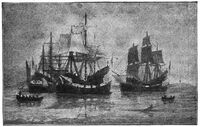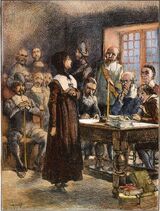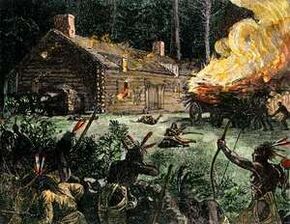Early Immigrant Ships to New England[]
- Immigrant Ships of New England : 1600 - 1725 : Voyage details and passenger lists.
First New England Colonies[]
1620 Plymouth Colony Settlement[]
1623 Wesseagussett Colony[]
Wesseagussett Colony AKA: Weymouth, Massachusetts - First settled in 1623, but partially abandoned, absorbed into Plymouth Colony.
- Edward Smith (1604-1675) - settled at Weymouth MA prior to 1642.
1625 Mare Mount Colony[]
Merrymount Colony was a short lived colony at Quincy, Massachusetts : 1625-1630. When Winthrop and over 900 Puritans arrived in 1630, they and Plymouth Colony forced the Mare Mount settlers to leave.
1629 Pistacaqua Colony[]
Pistacaqua Colony was an English settlement made circa 1629 on the Pistacaqua River near Portsmouth, New Hampshire and the border between present date New Hampshire and Maine.
1630 Massachusetts Bay Colony[]
1630 Saybrook Colony[]
1630: Winthrop Fleet Migration[]

This family were some of the 700+ Passengers of the Winthrop Fleet which sailed from England to settle the Massachusetts Bay Colony at Salem in 1630 under the guidance of Gov. John Winthrop. It is reported that during the first year nearly 200 of these colonists died and another 100 returned to England. The remaining settlers either stayed in Salem or moved on to Boston or Watertown.
- Notable settlers include John Warren (1585-1667),
- Marlborough First Settlers: 1656 - Marlborough MA.
1636: Antinomian Controversy[]

In 1636-1638, Massachusetts Bay Colony, this family were Free Grace Advocates (AKA: Antinomian Controversy) which caused great religious and political strife in the colony. It pitted most of the colony's ministers and magistrates against some adherents of the Free Grace theology of Puritan minister John Cotton. The most notable Free Grace advocates, often called "Antinomians", were charismatic Anne Hutchinson, her brother-in-law Reverend John Wheelwright, and Massachusetts Bay Governor Henry Vane. In the summer of 1637 their opponents led by Gov John Winthrop won back political control of the colony. The following trial led to the banishment many of the leaders of this movement.
See Also:
- Winthrop Fleet Passenger List
- Governors of Rhode Island
- Free Grace Advocates of 1636
- List of early settlers of Rhode Island
- Portsmouth Compact
- Rhode Island Royal Charter
- Early Colonial New England Conflicts
- List of lieutenant governors of Rhode Island
- Warwick Settlement 1642
1636 Early Connecticut Settlements[]
1636-38 Pequot Indian War[]

A 19th-century engraving depicting an incident in the Pequot War.
The Pequot War was an armed conflict that took place in 1636 and ended in 1638 in New England, between the Pequot tribe and an alliance of English colonists from the Massachusetts Bay, Plymouth, and Saybrook colonies and their allies from the Narragansett and Mohegan tribes. The war concluded with the decisive defeat of the Pequot. At the end, about 700 Pequots had been killed or taken into captivity.[1] Hundreds of prisoners were sold into slavery to colonists in Bermuda or the West Indies;[2] other survivors were dispersed as captives to the victorious tribes.
- Participants of the Pequot War
- John Oldham (1592-1636) - Murder of old trader triggers Anglo-Indian conflict known as Pequot War.
1638 Great Earthquake[]
In 1638, a "violent" earthquake was felt throughout New England, centered in the St. Lawrence Valley. This was the first recorded seismic event noted in New England. (Source: "Canada quake shakes Vt.": Burlington Free Press. 24 June 2010. pp. 1A,4A.)
1636 Rhode Island Settlements[]
See also Wikipedia Source:
- Outline History of Rhode Island
- Early Settlers of Rhode Island
- Roger Williams - Founder of Rhode Island
- Providence Civil Compact - 1637: 1st Plantation in Rhode Island, by Roger Williams and his followers.
- Settlers of Cocumscussoc (Wickford) area
- Portsmouth Compact - 1638: 2nd Plantation in Rhode Island
- Inhabitants of Aquidneck Island (1638)
- Newport Settlement 1639 - 3rd Plantation in Rhode Island
- Warwick Settlement 1642 - 4th Plantation in Rhode Island
- Pettaquamscutt purchasers
- Early inhabitants of New Shoreham (Block Island)
- Rhode Island Royal Charter - 1663: Formal founding of Colony
- Early inhabitants of Westerly
- Colonial leaders during King Philip's War
- Original proprietors of East Greenwich
- Settlers of Frenchtown
- Other prominent Rhode Island early settlers (pre-1700)
1641 Springfield Acquisition[]
In 1641, Massachusetts expanded inland significantly, acquiring the Connecticut River Valley settlement of Springfield, which had recently disputed with, and defected from its original administrators, the Connecticut Colony. This established Massachusetts' southern border in the west, though surveying problems resulted in disputed territory until 1803–04.
English Civil Wars 1642-1651[]
Cromwell and the Parliamentarians overthrew Charles I of England (1600-1649). In the following Scottish Campaign (1650-51), many Scots who fought to put Charles II of England (1630-1685) back on the thrown were badly defeated and many shipped off to live in New England.
- John Fay (1641-1690) - Scottish soldier sent to New England
Kieft's War (1643-45)[]
Kieft's War, also known as the Wappinger War, was a conflict (1643–1645) between settlers of the nascent colony of New Netherland (population 800?) and the native Lenape population in what would later become the New York metropolitan area of the United States. The war had a terrible impact on the colonists, many of whom returned to the Netherlands. A relative peace lasted until the 1650s when growing competition for resources contributed to the outbreak of the Esopus Wars. In 1664, much of New York is captured by the English during the Second Anglo-Dutch War.
1643 Pelham Bay Massacre[]
- Anne Marbury (1591-1643), famous religionist and much of her family are killed after moving from Massachusetts to the Bronx (New Amsterdam) by Indians during Kieft's War.
1645 Lenape Tribe attack[]
- Samuel Luther (1636-1716) - survives Indian massacre at age 9
1659 Execution of Boston Martyrs[]
Persecution of Quakers in New England (See Wikipedia - Boston Martyrs)
1660 Restoration of English Crown[]
Charles II of England (1630-1685) was restored to the English throne on 25 May 1660. Although Charles and Parliament granted amnesty to Cromwell's supporters in the Act of Indemnity and Oblivion, 50 people were specifically excluded. In the end nine of the regicides were executed: they were hanged, drawn and quartered; others were given life imprisonment or simply excluded from office for life. Many of their family members and supports fled to New England to escape legal prosecution.
- William Throop (1628-1704) - Changed his name and migrated to New England with several relatives. Son of Adrian Scrope (1601-1660), one of the executed regicides.
1675-78: King Philip's War[]

King Philip's War 1675-1678, (sometimes called the First Indian War, Metacom's War, Metacomet's War, or Metacom's Rebellion) was an armed conflict between Native American inhabitants of present-day New England and English colonists and their Native American allies in 1675–78. The war is named for the main leader of the Native American side, Metacomet (1636-1676), who had adopted the English name "King Philip" in honor of the previously-friendly relations between his father and the original Mayflower Pilgrims. The war continued in the most northern reaches of New England until the signing of the Treaty of Casco Bay in April 1678.
- Category:Military participants in King Philip's War
1689 Glorious Revolution[]
After the Glorious Revolution in 1689, Bostonians overthrew the royal governor Sir Edmund Andros. They seized dominion officials and adherents to the Church of England during a popular and bloodless uprising.
1688-97 King Williams War[]
1st French & Indian War (North America)[]
King William's War (1688–97, also known as the Second Indian War, Father Baudoin's War, Castin's War, or the First Intercolonial War in French and named for King William of England) was the North American theater of the Nine Years' War (1688–97, also known as the War of the Grand Alliance or the War of the League of Augsburg). It was the first of six colonial wars (see the four French and Indian Wars, Father Rale's War and Father Le Loutre's War) fought between New France and New England along with their respective Native allies before France ceded its remaining mainland territories in North America east of the Mississippi River in 1763.
French privateers harass colonial shipping along the New England coast.
- Hanna Emerson (1657-1738) - taken captive during the Raid on Haverhill (1697), in which 27 colonists were killed.
- Raid on York, Maine (1692) - 25-Jan-1692, French and Abenaki indians attack the English village of York, Maine. 50 killed, many more taken captive.
Hudson Bay Campaign[]
- Hudson Bay (1686) / 1st Fort Albany / 2nd Fort Albany / York Factory / Hudson Bay (1697)
Quebec and New York Campaign[]
Lachine / Schenectady / QuebecLa Prairie/ Mohawk Valley / Wilton
New England, Acadia and Newfoundland[]
Dover / 1st Pemaquid / Salmon Falls / Port Royal / Falmouth / Chedabucto / 1st St. John / York / Wells / Placentia / Oyster River / Groton / 2nd St. John / 2nd Pemaquid / Chignecto / Fort Nashwaak / Newfoundland / Haverhill
1691 Province of Massachusetts Bay[]
In 1691, the colonies of Massachusetts Bay and Plymouth were united (along with present-day Maine, which had previously been divided between Massachusetts and New York) into the Province of Massachusetts Bay.[86] Shortly after the arrival of the new province's first governor, Sir William Phips, the Salem witch trials took place, where a number of men and women were hanged for alleged witchcraft.
1692 Salem Witch Trials[]
1701 Grant Settlement[]
- 4-Aug-1701: The Great Peace of Montreal was a peace treaty between New France and 39 First Nations of North America. Has sometimes been called the Grand Settlement of 1701,
1702 Queen Anne's War[]
2nd French & Indian War[]
AKA: War of the Spanish Succession END: Peace Treaty of Utrecht (1713) Names for Queen Anne of England. After the New England Conquest of Acadia in 1710, mainland Nova Scotia was under the control of New England, but both present-day New Brunswick and virtually all of present-day Maine remained contested territory between New England and New France.
French privateers harass colonial shipping along the New England coast.
- Raid on Haverhill (1708) - French & Indian raid on Haverhill, Massachusetts - 29 Aug 1708.
1716-1726: Golden Age of Piracy[]
Includes much of America coastline.
1722 Dummers War[]
The Dummer's War (1722–1725), (also known as Father Rale's War, Lovewell's War, Greylock's War, the Three Years War, the 4th Anglo-Abenaki War or the Wabanaki-New England War of 1722–1725), was a series of battles between New England and the Wabanaki Confederacy (specifically the Mi'kmaq, Maliseet, and Abenaki), who were allied with New France. The eastern theatre of the war was fought primarily along the border between New England and Acadia in present-day Maine as well as in Nova Scotia; the western theatre was fought in northern Massachusetts and Vermont at the border between Canada (New France) and New England. (During this time Massachusetts included present-day Maine and Vermont.)
1744 King George's War[]
3rd French & Indian War[]
AKA: War of Jenkins' Ear AKA: War of the Austrian Succession END: Peace Treaty of Aix-la-Chapelle (1748)
- James Adair (1714-1796) - record of battles in the south.
1749 Father Le Loutres War[]
Father Le Loutre’s War (1749–1755), (also known as the Indian War, the Micmac War and the Anglo-Micmac War), took place between King George's War and the French and Indian War in Acadia and Nova Scotia. On one side of the conflict, the British and New England colonists were led by British Officer Charles Lawrence and New England Ranger John Gorham. On the other side, Father Jean-Louis Le Loutre led the Mi'kmaq and the Acadia militia in guerrilla warfare against settlers and British forces.
1754-62 French & Indian War[]
Seven Years War (1754-1763)[]
The French and Indian War (1754–1763) comprised the North American theater of the worldwide Seven Years' War of 1756-1763. The war pitted the colonies of British America against those of New France, with both sides supported by military units from their parent countries of Great Britain and France, as well as by Native American allies.
The end result of this great war was a big of a stalemate in Europe, however in North America, where the British scored major military victories in Canada with the help of New England provincial forces, France lost much of its empire between the Appalachian Mountains and the Mississippi River.
In latter part of 1755, major indian raids (primarily Delaware, Shawnee and Mingo, principle allies of the French living in the Ohio Valley) were unleashed on the western frontier settlements of Pennsylvania and Virginia, causing significant loss of life and massive movement of anglo settlers who fled the region. Estimated 1500 killed, 1000 taken captive and many more fled the area.
- James Adair (1714-1796) - record of battles in the south.
- 8-Jun to 26-Jul-1747Siege of Louisbourg (Nova Scotia) was a pivotal operation of the Seven Years' War (known in the United States as the French and Indian War) in 1758 that ended the French colonial era in Atlantic Canada and led directly to the loss of Quebec in 1759 and the remainder of New France" (French North America) the following year.
- 10-Aug-1757: Massacre at Fort William Henry - Many Massachusetts provincial soldiers and camp followers are killed in the surrender of the fort by Indian allies of the French.
- 25/26-Oct-1757 : Treaty of Easton - a colonial agreement between British colonials and the chiefs of 13 Native American nations.
- 1763 : Pontiac's War - after the fall of Canada and New France, many indian tribes west of the Appalachian revolt against British settlers in the frontier territories. Many British forts overthrown. Settlers retreat to seaboard colonies.
1755 Cape Ann Earthquake[]
The 1755 Cape Ann earthquake took place off the coast of the British Province of Massachusetts Bay (present-day Massachusetts) on November 18. At between 6.0 and 6.3 on the Richter scale, it remains the largest earthquake in the history of Massachusetts. No one was killed, but it damaged hundreds of buildings in Boston and was felt as far north as Nova Scotia and as far south as South Carolina.
1770 Boston Massacre[]
1772 Gaspee Affair[]
British revenue schooner, HMS Gaspee, looted and torched near Warwick RI.
1775 American Revolutionary War[]
1777 Vermont Constitution[]
The Constitution of the Vermont Republic, adopted in 1777, represented the first partial ban on slavery. Vermont became a state in 1791, but did not fully ban slavery until 1858 with the Vermont Personal Liberty Law.
1780 Massachusetts Constitution[]
Adams was highly involved in the push for separation from Britain and the writing of the Massachusetts Constitution in 1780 which, in the Elizabeth Freeman and Quock Walker cases, effectively made Massachusetts the first state to have a constitution that declared universal rights and, as interpreted by Supreme Judicial Court Chief Justice William Cushing, abolished slavery. David McCullough points out that an equally important feature was its placing for the first time the courts as a co-equal branch separate from the executive.
1786 Shays Rebellion[]
From 1786 to 1787, an armed uprising, known as Shays' Rebellion led by Revolutionary War veteran Daniel Shays wrought havoc throughout Massachusetts, and ultimately attempted to seize the U.S. Federal Armory at Springfield. The rebellion was one of the major factors in the decision to draft a stronger national constitution to replace the Articles of Confederation.
1788 Federal Constitution Convention[]
On February 6, 1788, Massachusetts became the sixth state to ratify the United States Constitution.[101]
War of 1812[]
1820 Maine Separation[]
In 1820, Maine separated from Massachusetts and entered the Union as the 23rd state as a result of the ratification of the Missouri Compromise.
See Also[]
References[]
- ^ John Winthrop, Journal of John Winthrop. ed. Dunn, Savage, Yeandle (Cambridge, MA: Harvard University Press, 1996), 228.
- ^ Lion Gardiner, "Relation of the Pequot Warres", in History of the Pequot War: The Contemporary Accounts of Mason, Underhill, Vincent, and Gardiner (Cleveland, 1897), p. 138; Ethel Boissevain, "Whatever Became of the New England Indians Shipped to Bermuda to be Sold as Slaves," Man in the Northwest 11 (Spring 1981), pp. 103–114; Karen O. Kupperman, Providence Island, 1630–1641: The Other Puritan Colony (Cambridge, MA: Harvard University Press, 1993), p. 172
Categor:Conflicts of Colonial New England